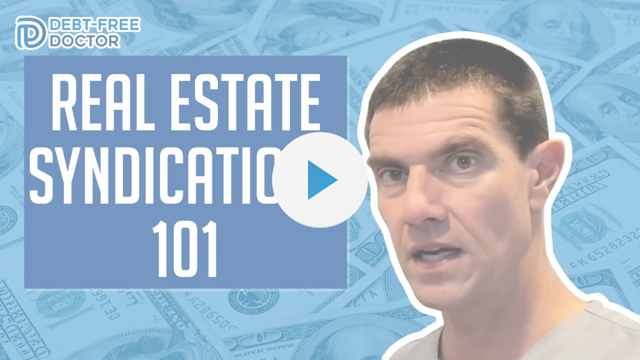When I finished dental training at LSU, I was focused on one thing: getting rid of the $300K student loan debt I’d accrued.
I understood the value of investing as early as possible (I didn’t start practicing until my early 30’s); but again, I was in survival mode.
You see, only two weeks before I finished my training in periodontics, the group I was supposed to join scratched our deal.
I went from being on an all-time high, finally seeing the finish line, to feeling as if I was starting all over.
Unfortunately, dental & medical school don’t teach us the important things we should know:
- how to run a business/practice
- financial education
At that time, the only investing advice I’d been given was to put my money in the stock market (i.e. 401k) for the “long term” and then reap the benefits when I was 70.
Yippee skippy.
There’s nothing wrong with investing like this if you want to work for 40 years with no other options.
But here’s the deal. There ARE other options and luckily I found one before it was too late…investing for cash flow via real estate syndications.
Don’t Miss Any Updates. Each week I’ll send you advice on how to reach financial independence with passive income from real estate.
Sign up for my newsletterWhat Is a Real Estate Syndication?
Before we discuss what a syndicator is, let’s first define real estate syndication deals.
A real estate syndication is the pooling of funds from a group of investors to form a partnership in order to purchase a property (i.e. apartment complex) that’s more expensive than any could have afforded on their own (unless your Elon Musk 🙂 ).
So instead of buying several smaller commercial properties individually, the group can buy a larger asset together. Usually a limited liability company (LLC) is formed and investors own a share of the LLC.
The majority of these deals are only available to someone that qualifies as an accredited investor.
Check out this video overview:

For example, let’s say I have $100,000 to invest.
If I was actively real estate investing, I’d be responsible for:
- trying to find investment opportunities
- getting property under contract
- performing due diligence
- handle financial issues
- perform the inspections
- obtain the loan
- keep it rented
- manage the property
For someone that still runs a full time practice, it’s next to impossible trying to continue to manage it along with being a good husband and father.
It’s for this reason that I’ve avoided becoming an active real estate investor at this point in my career.
That’s why I chose the passive investment route.
Investing in commercial real estate syndications allows you to put money into larger projects without having to do the work of finding or managing the property yourself.
So I can take the $100,000 and passively invest. It would be paired with someone that puts in $75,000 and another investor that puts in $250,000 and so on.
By pooling resources, there’s now enough to buy not just a rental property, but something bigger, like an apartment building.
What’s great about being a passive investor is we’re not involved in the day-to-day work of managing the property.
What Is a Syndicator?
There are typically two types of investors in syndications; the syndicator also known as the general partner (GP) or deal sponsor, and the limited partners (LP) also referred to as passive investors.
Let’s take a look at how each one is involved:
#1. Sponsor
The real estate sponsor is also known as the operator of the deal, real estate syndicator or General Partner (GP).
As you can imagine, they play the most critical role in the investment process as they’re the ones that are “hands-on“.
This person or group is the one that:
- Find and acquire the investment property
- Make it available to investors
- Obtain financing
- Raise money to close deals
- Manages the property
- Develops an exit strategy
Not only does the sponsor invest their time, they also invest their own capital. Typically this amount can range from 5-20% of the total equity capital for the real estate investment.
#2. Passive Investors
Passive investors in syndications are also known as Limited Partners (LPs).
These are individual investors who are looking for more of a “hands-off” role while still being involved with real estate projects.
Their primary role is to provide the capital to acquire the real estate property.
They have no active responsibilities in managing the asset and will receive passive income in the form of quarterly distributions from the capital they invest in the deal.
Typically distributions start 6 months after the property closes.
Join the Passive Investors CircleWhat Are The Syndicator’s Role In a Syndication?
As we discussed earlier, the real estate syndication company play the most critical role being accountable for:
- putting deals together
- developing a business plan
- finding investors
- raising capital
- closing the deal
- property management until it is sold
In other words, they perform all of the hard work so that the passive investors don’t have to.
One of the most important parts that’s most misunderstood has to do with underwriting.
A syndicator must constantly and extensively underwrite deals to determine whether or not a particular asset should be acquired.
For the provided risk of a syndication investment, the syndicator should ensure that investors receive a good return.
Communication also play a big role within the syndication process. Once an asset is acquired, the real estate syndicate should provide clear and consistent communication with their real estate investors to keep them updated on the project through monthly or quarterly reports.
Other operations that are involved are:
- handling insurance
- providing K-1s to investors
- setting up bank accounts
- working with a property manager to ensure the project stays on track
Many times an asset manager will be hired to help to supervise the asset throughout the hold period. Their job is to guarantee that the syndicated property increases in income, cash flow, and profitability.
What Are The Risks Of Investing In Syndications?
As you’re probably aware, ANY type of investment is a risk. Syndications aren’t immune to risk either.
Business plan execution
One of the biggest risks lies in the execution of the business plan. In order to market a deal, sponsors tend to send out fancy, high-end investment summaries.
However, when the rubber meets the road, the main goal is whether or not they can execute on the business plan in the face of unforeseen circumstances.
Proven track record
Investors that work with sponsors who have a proven track record and prioritize capital preservation can help ensure that their capital will be protected and that they’ll do what they say they’re going to do.
Changing market and economic conditions are always a risk. No one can predict what market conditions will be like at the end of a project’s hold time.
For instance, if the projected hold time is 5 years, check to make sure that the loan term is for at least that long. Ideally you’d like to see it longer than 5 years.
Why? So there’s a buffer just in case sponsors need to hold the property longer than intended.
What about liability?
Occasionally limited partners stress concern over their personal liability. The good news is that it’s limited as you’re in a limited partnership with others.
At worst, you could lose your original investment capital but nothing more than that (e.g., you can’t lose your house).
How Do Sponsors Get Paid?
Here are several streams of profit a sponsor would expect to earn:
#1. Profit Split
A preferred return (pref) refers to the ordering in which profits from a real estate project are distributed to investors.
It’s a threshold return that limited partners are offered prior to the general partners receiving payment.
The standard preferred return is 6-7% of their current capital account (capital account is initially equal to their equity investment).
That is, the LPs will receive a return of up to 6% before the GP is paid. If the real estate cash flows 6%, the LP receive the 6% preferred return and the GP does not receive a profit split.
If the real estate cash flows less than 6%, the LP receives a return of less than 6%. If the real estate cash flows more than 6%, the LP receive their 6% preferred return and the remaining profits are split between the LP and GP.
Typically, the preferred return is considered a return on capital. That is, the preferred return distributions do not reduce the LP’s capital account.
The profit split promotes hard work since the sponsor is financially incentivized to operate the asset so that the yearly return goes beyond the preferred return.
#2. Acquisition Fee
Most sponsors charge an acquisition fee which is a one-time charge paid at the time closing the property.
It varies from 1% to 5% of the purchase price, depending upon the size, scope, experience of the team, and earning potential of the investment.
This is similar to paying an acquisition cost to the sponsor for putting the project together.
#3. Asset Management Fee
The asset management fee is an annual charge paid to the syndicator in return for overseeing the operations of the property and executing the business strategy.
It’s either a portion of the gathered income or a per-unit each year cost.
The basic percentage range is 2% to 3%, while the standard per unit annually is $200 to $300.
#4. Refinance Fee
A refinancing fee is paid to the syndicator for any work required to re-finance the property.
If the business plan doesn’t result in a re-finance, the syndicator will not receive this fee.
#5. Guaranty Fee
This is normally a one-time fee, paid to a loan guarantor at closing for their role in guaranteeing the loan.
Occasionally the syndicator may induce a high net-worth person to sign on the loan to get the best financing terms.
The type of loan determines the cost.
Typically, there are two types of debts:
- recourse
- nonrecourse
Recourse financial obligation permits the loan provider to collect what is owed for the debt even after they’ve taken collateral.
Nonrecourse debt does not permit the lending institution to pursue anything other than security. The guaranty cost will be greater for recourse loans compared to nonrecourse loans.
Join the Passive Investors CircleInvesting In Real Estate Syndications
Now that you have a better understanding of what a syndication is and who is involved, let’s now discuss how to invest.
What’s the process for investing?
Here are the basic steps for investing in a real estate syndication:
- The sponsor announces that the deal is open for funding, usually via email.
- You review the investment summary deck and decide to whether or not to invest.
- You submit your offering, telling the sponsor how much you’d like to invest.
- The sponsor holds an investor webinar, where you can get more information and ask questions.
- The sponsor confirms your spot in the limited partnership and sends you the PPM (private placement memorandum).
- After signing the PPM, you wire in funds or send in a check.
- The sponsor confirms that your funds have been received.
- The sponsor notifies you once the deal closes and lets you know what to expect next.


